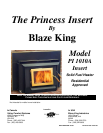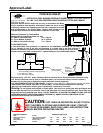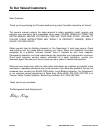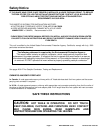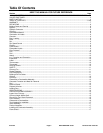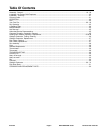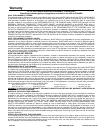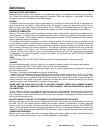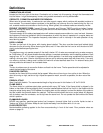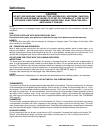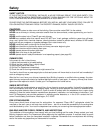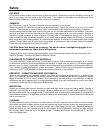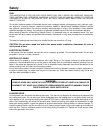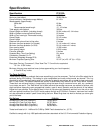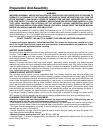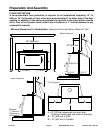Special offers from our partners!

Find Replacement BBQ Parts for 20,308 Models. Repair your BBQ today.

DATE PRINTED: 2/8/05 Revision Date: 02/01/05 PI-1010A Page 9
Definitions
COMBUSTION AIR INTAKE
Located on the front right of the stove. Combustion air is drawn into this opening, through the thermostat and
into the firebox. In tight contemporary homes, using outside combustion air may be desirable.
CREOSOTE - FORMATION AND NEED FOR REMOVAL
When wood is burned slowly, it produces tar and other organic vapors which combine with expelled moisture to
form creosote. The creosote vapors condense in the relatively cool chimney flue of a slow-burning fire. As a re-
sult, creosote residue accumulates on the flue lining. When ignited, this creosote makes an extremely hot fire.
PREVENT CREOSOTE FIRES: Inspect Chimney Connector and Chimney TWICE monthly and clean if neces-
sary. If a chimney fire starts, close the loading door and turn the thermostat to the lowest setting. Call the fire de-
partment immediately.
The basic design of this catalyst equipped stove will reduce creosote accumulation to a very low level. However,
the frequency of start-up operations and the temperature at which the stove is operated on a regular basis can
affect that accumulation. The inspection frequency noted above is still a vital step in the safe operation of any
wood burning system.
DOOR, LOADING
The door on the front of the stove, with viewing glass installed. This door must be closed and latched tightly
whenever the fire is burning. When cleaning the stove, wait 1/2 hour after the fire is out or until the stove is suffi-
ciently cooled before opening the door.
DRAFT
This appliance may not operate properly if the draft is below .02” of water as measured using a water manome-
ter. Draft below .02” will cause excessive smoke spillage, incomplete combustion and fire startup problems. Draft
ranging from .02" to .10" of water is suggested for normal operation. Low draft may sometimes be improved by
making a chimney taller. Exterior chimneys may be too cold to achieve proper draft with these units. If an exte-
rior masonry chimney is being used it should be lined with a listed stainless steel liner. An external factory built
chimney should be enclosed in an insulated chase.
FAN
The fan circulates room air across the firebox and back into the home. The fan speed should be adjusted to
match the heat output of the stove.
FAN SPEED CONTROL
Located on the lower left this controls the fan speed. When stove is burning on low, set fan to low. When the
stove is burning on high, set fan to high. Adjust fan speed to match, as much as possible, the burn rate of the
stove.
FIREBOX, STOVE
Steel, lined with firebrick. The recommended length of log to be used in this firebox is 16" for PI1010A.
FLAME SHIELD
The flame shield is a stainless steel plate, punched with many 3/8" holes. If the flame shield is shipped in the
firebox or has fallen off during shipping then it must be installed before the first fire. Hold it in the firebox with the
triangular wings facing away. Lift it between the loading door and the catalyst, and rest the bottom of the plate on
the two holders that protrude below the catalyst. The flame shield should rest at an angle (about 45 degrees)
with its bottom near the combustor, and its top near the stove front. Do not operate the stove without the flame
shield in position.
FLAMMABLE LIQUIDS
NEVER use gasoline, gasoline-type lantern fuel, kerosene, charcoal lighter fluid or similar liquids to start or
"freshen up" a fire in this stove. Keep all such liquids well away from the stove while it is in use.
FLOOR PROTECTOR
Noncombustible surfacing applied to the floor area extending in front of the insert. Floor protector sizes are
shown on page 16.



